Haryana State Board HBSE 7th Class Maths Solutions Chapter 5 Lines and Angles Ex 5.1 Textbook Exercise Questions and Answers.
Haryana Board 7th Class Maths Solutions Chapter 5 Lines and Angles Exercise 5.1
Question 1.
Find the complement of each of the following angles:
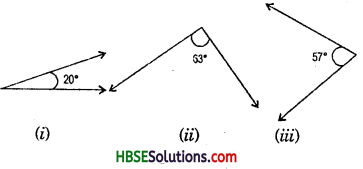
Solution:
If the sum of two angles is 180°, then they are said to be supplementary angles and each of them is called the supplement of the other.
(i) 180° -105° = 75°
(ii) 180°-87° = 93°
(iii) 180°-105° = 75°.
![]()
Question 2.
Find the supplement of each of the following angles:

Solution:
If the sum of two angles is 180°, then they are said to be supplementary angles and each of them is called the supplement of the other.
(i) 180° — 105° = 750
(ii) 180° — 87° = 93°
(iii) 180° — 105° = 75°.
Question 3.
Identify which of the following pairs of angles are complementary and which are supplementary.
(i) 65°, 115°
(ii) 63°, 27°
(iii) 112°, 68°
(iv) 130°, 50°
(v) 45°, 45°
(vi) 80°, 10°
Solution:
Complementary angles = 90° Supplementary angles = 180°
(i) 65° + 115° = 180° = Supplementary
(ii) 63° + 27° = 90° = Complementary
(iii) 112° + 68° = 180° = Supplementary
(iv) 130° + 50° = 180° = Supplementary
(v) 45° + 45° = 90° = Complementary
(vi) 80° + 10° = 90° » Complementary.
Question 4.
Find the angle which is equal to its complement.
Solution:
∵ Let the required angle be x. v It is equal to its complement,
∴ x = 90° – x
⇒ x + x = 90°
⇒ 2x = 90°
∴ x = \(\frac{90^{\circ}}{2}\) = 45
Thus, 45° is equal to its complement.
![]()
Question 5.
Find the angle which is equal to its supplement.
Solution:
Let the required angle be x and supplement of x = 180 – x
∴ x is equal to its supplement .
∴ x = 180° – x
x + x = 180°
2x = 180°
∴ x = \(\frac{180^{\circ}}{2}\) = 90°
Thus, 90° is equal to its supplement.
Question 6.
In the given figure ∠1, and ∠2 are supplementary angles. If E ∠1 is decreased, what changes should take place in ∠2 so that both the angles supplementary.

Solution:
∠1 + ∠2 = 180° .
Supplementary angles if ∠1 is decreased, then 2 is increased but ∠1 + ∠2 = 180°
Hence, 2 is increased so that the sum of the two angles remains the same.
Question 7.
Can two angles be supplementary if both of them are :
(i) acute (ii) obtuse (iii) right ? Sol: Supplementary = 180°
acute angle = < 90° acute angle = > 90°
acute angle = 90°
(i) No, (ii) No, (iii) Yes [because 90° + 90° = 180°]
Question 8.
An angle is greater than 45°. Is its complementary angle grater than 45° or equal to 45° or less than 45° ?
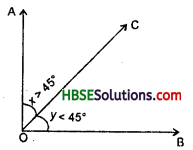
Solution:
A-t-q,
∠AOC < 45°
And BOC < 45°
Because ∠AOC + ∠BOC = 90°
= Complementary angles
Hence, It is complementary and one angle is greater than 45° and other is less than 45″.
![]()
Question 9.
In the given figure
(i) Is ∠1 adjacent to ∠2 ?
(ii) Is ∠AOC adjacent to ∠AOE?
(iii) Do ∠COE and ∠COD form a linear pair ?
(iv) Are ∠BOD and ∠DOA supplementary ?
(v) Is ∠1 vertically opposite to ∠4 ?
(vi) Wliat is the vertically opposite angle of ∠5 ?
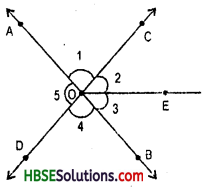
Solution:
(i) Yes
(ii) No, Because OC and OA are not on the opposite side of OE.
(iii) No, Because ∠COE + ∠COD 180°.
(iv) Yes, Because ∠BOD + ∠DOA = 180° Supplementary.
(v) Yes.
(vi) (∠2 + ∠3) is the vertically opposite angle of ∠5.
Question 10.
Indicate which pairs of angles are
(i) Vertically opposite angles.
(ii) Linear pairs.
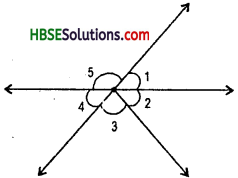
Solution:
(i) ∠1 = ∠4
i.e. ∠l, ∠4
(ii) ∠4 + ∠5 = 180′ i.e., ∠4, ∠5
and ∠1 + ∠2 + ∠3= 180°,i.c., ∠1, ∠2, ∠3
and ∠1 + ∠5 = 180″, i.e., ∠1,∠5
Question 11.
In the given Fig. is ∠1 adjacent to ∠2 ? Given reasons.
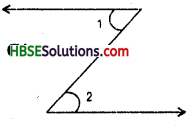
Solution:
No, ∠1 and ∠2 are not adjacent angles because they do not have a common vertex.
Question 12.
Find the values of the angles X, Y and Z in each of the following:
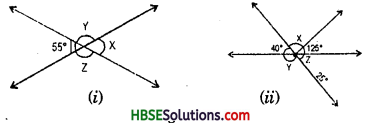
Solution:
(i) ∠X = ∠55°
= Vertically opposite angles and
∠X + ∠Y = 180° = Linear pairs
or, ∠55° + ∠Y = 180°
or, ∠Y = 180°-55°
∴ ∠Y = 125°
and ∠Y = ∠Z = Vertically opposite
angles
125° = ∠Z Fig.
∴ ∠Z = 125°
i.e., X = 55°, Y = 125°, Z = 125°.
(ii) ∠Z = 40
= Vertically opposite angles and
∠Y + 40° = Linear pairs = 180°
or, ∠Y = 180° – 40° = 140°
∴ ∠Y = 140°
Now, ∠Y = ∠X + ∠25°
= Vertically opposite angles
or, 140° = ∠X + ∠25°
or, 140°-25° = ∠X
or, 115° = ∠X
∴ ∠X = 115°
i.e., X = 115°, Y = 140°, Z = 40°.
![]()
Question 13.
Fill in the blanks :
(i) If two angles are complementary, then the sum of their measures is ……………..
(ii) If two angles are supplementary, then the sum of their measures is …………
(Hi) Two angles forming a linear pair are …………….
(iv) If two angles are supplementary, they form a ………………
(v) If two lines intersect at a point, then the vertically opposite angles are always ………….
(vi) If two lies intersect at a point, and if one pair of vertically opposite angles are acute angles, then the other pair of
vertically opposite angles are ……………………
Solution:
(i) 90°. (it) 180°. (iii) adjacent angles. (iv) linear pair (u) equal, (vi) obtuse angles.
Question 14.
In the Fig., name the following pairs of angles.
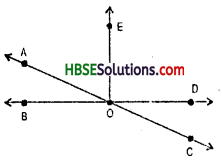
(i) Obtuse
vertically opposite angles
(ii) Adjacent complementary angles
(iii) Equal supplementary angles
(iv) Unequal supplementary angles
(v) Adjacent angles that do not form a linear pair.
Solution:
(i) ∠BOC = ∠AOE + ∠EOD, i.e., ∠BOC, (∠AOE + ∠EOD)
(ii) ∠AOB + ∠AOE = 90°, i.e., ∠AOB, ∠AOE
(iii) ∠BOE + ∠EOD = 180°, i.e., ∠BOE, ∠EOD
(iv) ∠AOB + ∠BOC = ∠180°, i.e., ∠AOB, ∠BOC
(v) ∠COD and ∠DOE, ∠DOE and ∠EOA, ∠BOA and ∠AOE.